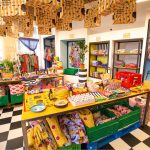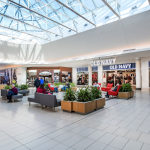What is a pop-up shop? Everything you need to know to try short-term retail > 23 Smart Pop Up Shop Ideas to Steal From These Successful Brands > How Pop-Up Stores Can Help You Take Your Product Development to the Next Level
Pop-up stores have become an increasingly popular way for businesses to test out new products and gauge customer interest. It’s a great way to get feedback on products, and it’s also a great way to increase brand awareness. In this blog post, we’ll discuss the different ways that pop-up stores can be used to develop products and boost sales.
Benefits of using a pop-up store for product development

Utilizing a pop-up store as a tool for product development can be hugely beneficial for companies; it is the perfect way to get valuable, real-time customer feedback on their offerings. Going beyond traditional market research and focus groups, pop-ups actively allow customers to engage with a product or service in person and give immediate, honest feedback that companies can use to shape the future of their products.
The pop-up store provides an exciting way for brands to test out new ideas and explore wider markets. Pop-up stores are an ideal tool for product development, offering companies the opportunity to test out their products without incurring long-term leases. This makes them a cost-effective way of exploring new concepts and products before launching them into the market. Plus, pop-up stores are also a great way to build interest in your brand and experiment with innovative ideas.
Additionally, pop-up stores effectively reach potential customers and spread awareness of a product or service. By engaging with shoppers in a physical setting, it offers brands an opportunity to connect on a personal level and generate enthusiasm for their products or services. Furthermore, pop-up stores provide invaluable feedback on customer preferences that can help inform future product iterations. All in all, the pop-up store is an essential tool for promoting brand awareness and developing new products.
How can a pop-up store advance product development?

Pop-up stores offer an ideal opportunity for businesses to develop and test new products and services before launching them in the larger market. These stores provide businesses with the flexibility to trial products in a real-life environment and quickly make changes based on customer feedback. By allowing businesses to use the pop-up store as a tool for product development, they gain invaluable insights that are essential for a successful market launch.
Pop-up stores are proving to be a great tool for product development, offering businesses the perfect opportunity to interact with customers and gain valuable insight into their feedback. Not only do they allow businesses to observe customer preferences and adjust their products accordingly, but they also provide companies with an ideal platform to assess the success of a product before committing more resources.
Also, the pop-up store is a great tool for product development as it allows companies to test out their products and gauge customer interest without making a large financial investment. This means they can receive immediate feedback from consumers and effectively respond to market trends in near real-time. Pop-up stores effectively reach potential customers, increase brand visibility and ultimately create stronger connections with the target audience.
Bottom-up approach
Defining a brand’s identity and developing a product is often regarded as a top-down process. Working from such an understanding means a brand’s message is announced, customers are enticed or convinced, and products are sold. However, if we think in terms of dialogue, a brand becomes a story, customers are participants, and the outcome of that conversation is a product.
Pop-up stores follow such logic very well. Both starting and established brands can use pop-ups to enter new markets at the local level, engage customers in a personal way, start a conversation and build loyalty. Involving customers in the process of product development facilitates a shared sense of ownership and changes your customer base from ‘audience’ to ‘community’. This is more sustainable in the long run.
In the end, it is all about customer experience, which relates to how customers perceive the full scope of their interactions with your brand. According to Huffington Post, 70% of companies that deliver outstanding customer experience rely strongly on customer feedback.
Pop-ups for Start-ups
Sometimes an idea pops up, followed by a strong conviction that you’re on to something. In 2016, this happened to Amrita Singh, Lindsay Agnew and Jo Lusted, who were inspired to visit San Francisco to test a business about toast during a holiday. Noticing a unique food trend in California offered by toast cafes, the friends began to fantasize about trying out a similar concept in Toronto.
Unable and too unsure to rent a permanent storefront, they opened a small weekend-only pop-up store, aptly named TOAST, for a couple of weeks in the waiting room of a dermatology clinic. Drawing heavily on social media, they were able to attract customers, test the market, get feedback and improve their products on the spot.
In this case, the pop-up strategy allowed the three entrepreneurs to act quickly, keep costs to a minimum and refine their product in direct response to their customers’ feedback. In addition, this low-key, local, and personal approach became part of the brand’s origin story, which adds to its charm and relatability.
The small brewery Hopper Bräu, based in Hamburg, tells a similar start-up story. Before entering the market confidently with their brand of beers, they ran a pop-up store for four months in the ‘Rindermarkthalle St. Pauli’. Initially serving two experimental beers, founder Lars was excited to learn from customer feedback, directly interact with potential customers and find out whether his enthusiasm was shared by others. The launch party was attended by over 200 people, and within 6 weeks, the first ration was completely sold out and needed to be replenished.
Keeping the conversation going
That start-ups are mindful of customer feedback is not surprising. The true challenge is to grow your brand and become established without suffering from so-called consumer amnesia, where – apart from selling situations – companies forget how to have routine conversations with customers.
LEGO is a case in point when it comes to a brand that continues to include customers – both young and old. Regularly using pop-up venues around the world to touch base, LEGO also set up LEGO Ideas, an online community where fans can share creations and submit product proposals. If a proposal gets 10.000 votes, LEGO reviews the idea. Periodically a winner is announced. The creator will not only be consulted for final product approval but will also be acknowledged on all packaging and marketing and earns a percentage of the global sales of the product.
Another company that involves customers in its innovations is DHL, the world’s largest mail and logistics services company. DHL frequently organizes hands-on workshops in Germany and Singapore to think about solutions that can improve the experience for everyone.
One of the inventions that came from such a workshop was the Parcelcopter, a completely autonomous drone that delivers goods to people’s doorsteps in hard-to-reach locations. The business results for DHL have been amazing. According to Forbes, DHL’s efforts to involve customers in product development have resulted in customer satisfaction scores rising to over 80% and have caused customer churn to decrease.
The versatility of pop-ups
Whatever your business may be, and at whatever stage it may find itself, the merits of involving customers in both brand and product development are clear.
Launching a pop-up as a start-up is a good way to test the market and refine your product before taking the big leap. As an established brand, a pop-up can be a great way to keep in close touch with customers, test a new product line, involve them in innovation or include them in a creative community.
The pop-up venue can serve a lot of different functions. As this understanding continued to dawn upon both starting and established brands over the coming years, we can see many creative interpretations of the pop-up.
Conclusion: Leveraging the power of the pop-up store for product development

Pop-up stores are a great tool for product development, as they allow companies to experiment with new products or different versions of existing products without a large financial commitment. This is beneficial as it provides real-life feedback on how well the product performs, which can be invaluable when considering what to hold in stock or launch further down the line. Using pop-up shops instead of traditional retail outlets offers businesses an innovative and cost-effective way to gain insights and review their current offerings.
Pop-up stores are a great tool for product development, allowing customers to have an immersive experience and create buzz around a launch or re-launch. There’s no better way to get people excited about your new products than by creating an interactive pop-up environment that allows them to try the product and share their experience with others. Pop-ups can also be used as an opportunity for feedback, where customers can provide valuable insight into how the product should be improved or changed.
Thus, pop-up stores are a great way to test out new ideas and products before committing to a major launch or expansion. They offer valuable data that can help inform the decision-making process, helping to ensure the success of any product development project. Furthermore, with their flexible and experiential nature, pop-up stores provide companies with immense potential as effective tool for product development.
- How to Open a Successful Pop-Up Shop in London’s Fast-Fashion Neighborhoods - December 23, 2022
- The Benefits of Opening a Pop-Up Shop in NYC’s Fast-Fashion Neighborhoods - December 23, 2022
- Reaping the Benefits of Long-Term Pop Up Stores: Tips and Advice - December 23, 2022





